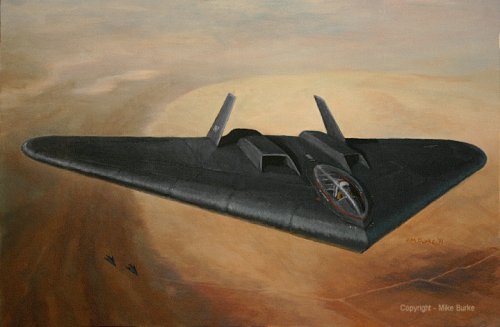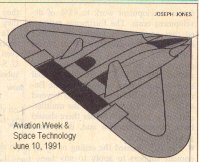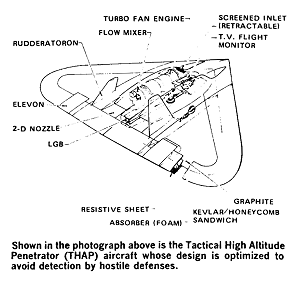NORTHROP THAP demonstrator
(Tactical High Altitude Penetrator)
Status: proof-of-concept vehicle, probably under contract from USAF
Powerplant: One or two turbofan powerplants of unknown make
Alleged first flight: 1981, from the Groom Lake facility
In 1976, the Air Force began RCS and wind-tunnel tests of the Northrop proposal. Late in 1978, Northrop supposedly won a contract to build and flight-test a prototype technology demonstrator based on its THAP (Tactical High Altitude Penetrator) design. The first flight of the experimental prototype is claimed to have taken place in mid-1981 at about the same time that flight testing began on the first full-scale development Lockheed F-117 prototype derived from the XST. The piloted THAP demonstrator was allegedly about the size of a fighter-bomber, such as the F-18, and had a maximum takeoff weight of 55,000 to 60,000 pounds and a wingspan of 56 feet. In marked contrast to the XST and the F-117, the Northrop THAP is claimed to have rejected the use of two-dimensional faceting and instead adopted a rounded manta-ray shape (or triangular spanloader concept) with extensive use of RAM. The aircraft supposedly more closely resembled the Northrop XST submission or even a flying wing than the Lockheed "Hopeless Diamond" concept. After a successful flight-test program, Northrop is claimed to have received a follow-on contract in 1981 for the development and manufacture of 30 operational versions of its stealthy reconnaissance aircraft prototype.
The reported TR-3A stealthy tactical reconnaissance aircraft has traditionally been thought to be a development of Northrop's THAP studies conducted in the late 1970s. These studies envisioned a twin-engined subsonic stealth spanloader. Interestingly, the design did not feature a pure recon aircraft, but instead was also armed with a single Paveway II laser guided bomb. Since Northrop constructed several electrically insulated wind tunnels in the late 1970s, it has been estimated that the company's invention to use electrostatic forces to control the airflow over a wing had been applied to the THAP. Northrop reportedly received an Air Force contract to build 20-30 airframes under the name Tactical Survivable Aircraft (TSA) in 1983.
The single-pilot THAP design concept was a spanloader airframe design. The original design reportedly relied heavily on radar-absorbing material (RAM) — as well as blended, curved surfaces — to reduce its radar cross section. This would contrast with the faceted surfaces of the F-117A and would probably result in a heavier aircraft than today's stealth fighter. The long-range reconnaissance mission, however, is more forgiving of extra weight than the combat mission.
Northrop's greater experience in directly related design and technology areas may have been the key to its victory in the competition. As one published account notes, developing the ATB bomber entailed significant technological risks relating to the aircraft's "complex curvatures, exotic materials, and other stealth methods." (Scott, 1991a, pp. 7-8.) Unknown to Lockheed in 1981, Northrop may have already been flying its prototype THAP spanloader for many months at the time it won the ATB competition. Clearly, Northrop would have accumulated significantly more experience than Lockheed in designing and developing the large curved and rounded flying-wing stealth designs necessary for long-range heavy bombers, if THAP actually existed. Indeed, Rich recounts that, when Lockheed's chief executive officer complained about the ATB decision to Vernon Orr, Secretary of the Air Force, he shot back that "not only was Northrop better than you, they were much better than you."
Press accounts assert that this led to an even larger aircraft called the TR-3A, which allegedly has a wingspan of 63 feet; a length of 42 feet; a maximum weight of 62,000 pounds; and a range in excess of 3,500 miles. Reports of the THAP being an operational aircraft as the TR-3A are numerous, but must be treated with suspicion.




